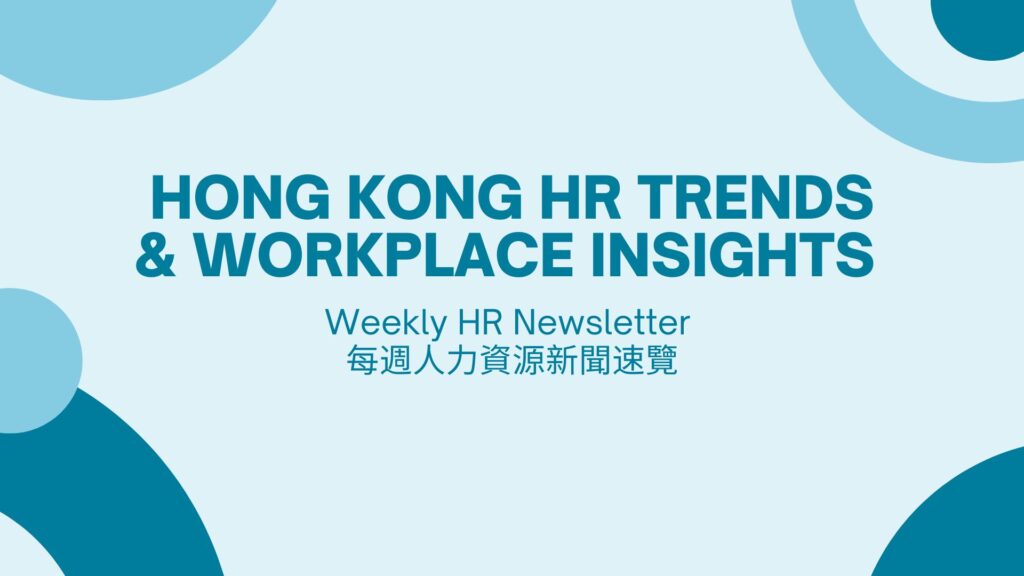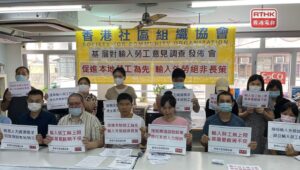04/05- 11/05/2025 Hong Kong HR Trends & Workplace Insights – Weekly HR Newsletter 每週人力資源新聞速覽

Hong Kong’s HR landscape is under pressure from all sides—policy shifts, economic constraints, and global scrutiny. This week’s MixCare Weekly unpacks five powerful forces reshaping the future of work in the city. From local workers being edged out by imported labour to another round of public sector pay freezes, the signals are clear: HR can no longer afford to react. Meanwhile, Rippling’s billion-dollar HR tech surge and Hong Kong’s global rebranding efforts hint at new opportunities—for attraction, digitisation, and talent mobility.
Whether you’re leading retention strategy, evaluating risk, or reshaping your EVP, this week’s news offers a sharp lens into what matters most—and what HR must do next.
1. Hong Kong Workers Complain of Losing Jobs to Imported Labour

One-Minute Summary
A Hong Kong government scheme to ease labour shortages by importing low-skilled workers from mainland China has sparked backlash from local workers. Over 200 restaurant employees report losing jobs or hours to imported workers, especially older or part-time staff. The scheme mandates fair local hiring and wages, but enforcement is reportedly weak. What began as a solution for manpower gaps is now revealing cracks in local labour protection.
3 Main Takeaways
- Local workers, particularly older and contract-based staff, are being replaced.
- Compliance with the scheme’s fair-hiring rules is questionable.
- Public frustration signals growing concern over job security.
Implications to HR
- Futureproof your local workforce through adaptive skills investment
This is the moment to reinvest in vulnerable talent pools. Upskill older and part-time staff to strengthen their relevance and confidence. - Redesign how you talk about job security and internal-value
Employees need clarity. Communicate your long-term commitment to local talent through mobility programs and fair redeployment practices. - Anticipate cultural friction and loyalty loss
A diverse workforce must be intentionally integrated. Use onboarding and team-building frameworks that celebrate inclusion, not just fill vacancies.
What this means for you:
HR leaders must recognise that policy changes—even if externally imposed—can cause internal shockwaves. This is an opportunity to lead from the front by reaffirming your social contract with employees. If people fear replacement, trust declines, productivity drops, and attrition rises. Review your internal mobility strategy, launch capability development for underrepresented employee segments, and communicate frequently about job protection and career continuity. These actions cost less than rehiring and help re-anchor employee commitment.
Source: South China Morning Post
2. Salary Freeze for Hong Kong’s Urban Renewal Authority

One-Minute Summary
The URA has frozen pay for 700 employees in 2025–26, mirroring the government’s broader austerity push. This is the second freeze in four years, aimed at easing budget strain. Performance bonuses remain, but morale is reportedly low, with employees fearing stagnation and lack of recognition.
3 Main Takeaways
- Base salaries are frozen again; performance bonuses still exist.
- Employees are concerned about long-term growth and reward.
- Similar freezes may follow in other sectors.
Implications to HR
- Transform “no raises” into a test of leadership equity
Managers must deliver transparent, empathetic communication and ensure recognition still feels fair. - Rethink your employee value proposition beyond cash
This is the time to enhance benefits, wellbeing support, and career development. Platforms like MixCare can fill the perceived gap in value. - Use fiscal constraints to foster innovation
Challenge teams to co-create purpose-driven initiatives that energize engagement without adding cost.
What this means for you:
If pay can’t grow, purpose must. HR needs to become the architect of non-monetary value: growth, flexibility, wellness, and belonging. Instead of retreating, lead with proactive planning. Launch role redesigns that increase autonomy. Use this chance to spotlight development opportunities, peer recognition programs, and team-based rewards. Done well, pay freezes can ironically boost alignment—if HR takes charge of the narrative and delivers new value in other ways.
Source: South China Morning Post
When salaries freeze, culture speaks.
With mounting financial pressure across sectors, employers need new ways to show value. MixCare supports Hong Kong HR teams with a flexible benefits platform that empowers employees to choose what matters most—whether that’s mental health, family care, or fitness.
From purpose-driven perks to smarter wellness design, we help you make compensation personal again—even when cash is tight.
👉 Explore how MixCare drives loyalty without lifting payroll →
3. “Curse of 35”: Age Bias Hits Chinese Tech Workers by Mid-Career

1-Minute Summary
In China’s tech sector, workers over age 35 are increasingly seen as “too old,” facing hiring caps and role instability.
This phenomenon, dubbed the “Curse of 35,” is spreading online and reflects deeper issues of ageism in fast-moving industries. It’s a wake-up call for global HR leaders to avoid replicating age-based exclusion as tech disruption continues.
3 Main Takeaways
- Age discrimination is real and rising, especially in fast-evolving sectors.
- Hiring and advancement stop early for many mid-career professionals.
The industry is undervaluing experience in favor of youth and speed.
Implications to HR
-
Run an Age Equity Audit
Examine job ads, promotion data, and pipeline leakage points. Address unconscious age bias in hiring and reviews. -
Launch Mid-Career Reskilling Programs
Offer structured pathways for experienced staff to pivot into digital, data, or strategic functions. -
Introduce “Wisdom Metrics” in Reviews
Recognize mentorship, systems thinking, and institutional knowledge as promotable contributions—not just agility or innovation.
What this means for you:
The “Curse of 35” isn’t just a China-specific trend—it’s a mirror reflecting what many fast-paced industries quietly tolerate: early-career obsession and mid-career neglect. If you’re not actively protecting against age bias, you may be losing high-potential talent at their peak value.
Now is the time to reframe career progression. HR leaders must ensure that internal mobility, mentorship, and upskilling aren’t only targeted at juniors. Build reskilling programs designed for mid-career professionals—those with deep knowledge but needing a pivot path.
Also consider the messaging in your employer brand: do your job ads, career tracks, and reward systems subtly signal “young and hungry only”? Flip the narrative. Highlight experience as an asset, not a liability. In doing so, you not only retain wisdom—you build an inclusive culture that adapts, rather than ages out.
Source: South China Morning Post
4. HR Tech Firm Rippling Raises New Funding at $16.8 Billion Valuation

One-Minute Summary
Rippling has raised US$450M, cementing investor belief in centralised HR tech. The platform offers integrated solutions across payroll, IT, benefits, and workforce management—with global expansion in sight. It signals the rising expectation for HR to operate digitally, smartly, and with measurable business impact.
3 Main Takeaways
- HR tech is growing fast, and investors are bullish.
- Integrated platforms are becoming the new standard.
- Asia is a key growth target.
Implications to HR
- Stop buying tech for admin ease—start investing for talent experience
Choose tools that improve employee perception and value, not just efficiency. - Your HRIS is now a culture tool
Every system reflects your values. Audit whether your digital workflows empower or frustrate. - Plan for AI-enhanced HR, not AI-replaced HR
Educate your team on AI’s role in HR and develop ethical frameworks for deployment.
What this means for you:
Technology now defines the employee journey. The bar is higher than ever—HR systems must now feel intuitive, inclusive, and aligned to your company culture. This news should push you to revisit your tech stack: Are your platforms supporting hybrid work? Personalisation? Decision-making? Start pilot projects using AI for onboarding, learning, or analytics. Your agility here positions HR not as a support function—but as a strategic enabler.
Source: Reuters
5. Hong Kong Works on Image Overhaul to Attract Overseas Visitors

One-Minute Summary
Hong Kong is revamping infrastructure, events, and its brand to reassert itself as Asia’s global gateway. Improvements include transport upgrades, digital payments, and large-scale cultural events. While tourism is the primary target, this move could reshape how international talent views working and living in the city.
3 Main Takeaways
- Hong Kong is investing heavily in reputation and experience.
- Economic recovery and vibrancy are expected to rise.
- International mobility and talent interest could grow.
Implications to HR
- Talent attraction is now a city-wide narrative
Align your employer brand with Hong Kong’s reinvention. Share stories that highlight lifestyle, connectivity, and innovation. - Prepare for mobility resurgence
Update your relocation policies and onboarding experience to meet new expectations. - Reignite pride in place
Embed local pride in culture-building—through community engagement, storytelling, and location-based benefits.
What this means for you:
Hong Kong’s renewed global identity is your recruitment advantage. Talent, especially regional or international candidates, want to see vibrancy, purpose, and future-forward positioning. HR can now tie relocation and retention narratives to the city’s momentum—highlighting culture, infrastructure, and opportunity. Rebuild your employer branding to reflect this energy. Turn “based in Hong Kong” from a neutral fact into a key selling point.
Source: Economic Times
When everything’s changing—your benefits strategy should be the most adaptable thing in your toolkit.
From navigating local labour policy shifts to responding to talent mobility and geopolitical risk, HR today demands agility. MixCare helps employers design personalised benefit plans that evolve with your people—whether you’re supporting local workers, global teams, or hybrid operations.
Built for change. Backed by data. Loved by employees.
👉 Talk to us about building an agile people strategy →
Want to stay on top of the latest HR trends, policy developments, and corporate response strategies every week?
Subscribe to the MixCare Weekly now — each week, we curate the five most important news stories in the industry to help you stay ahead in a rapidly changing market.
[formidable id=”9″ title=”1″]
